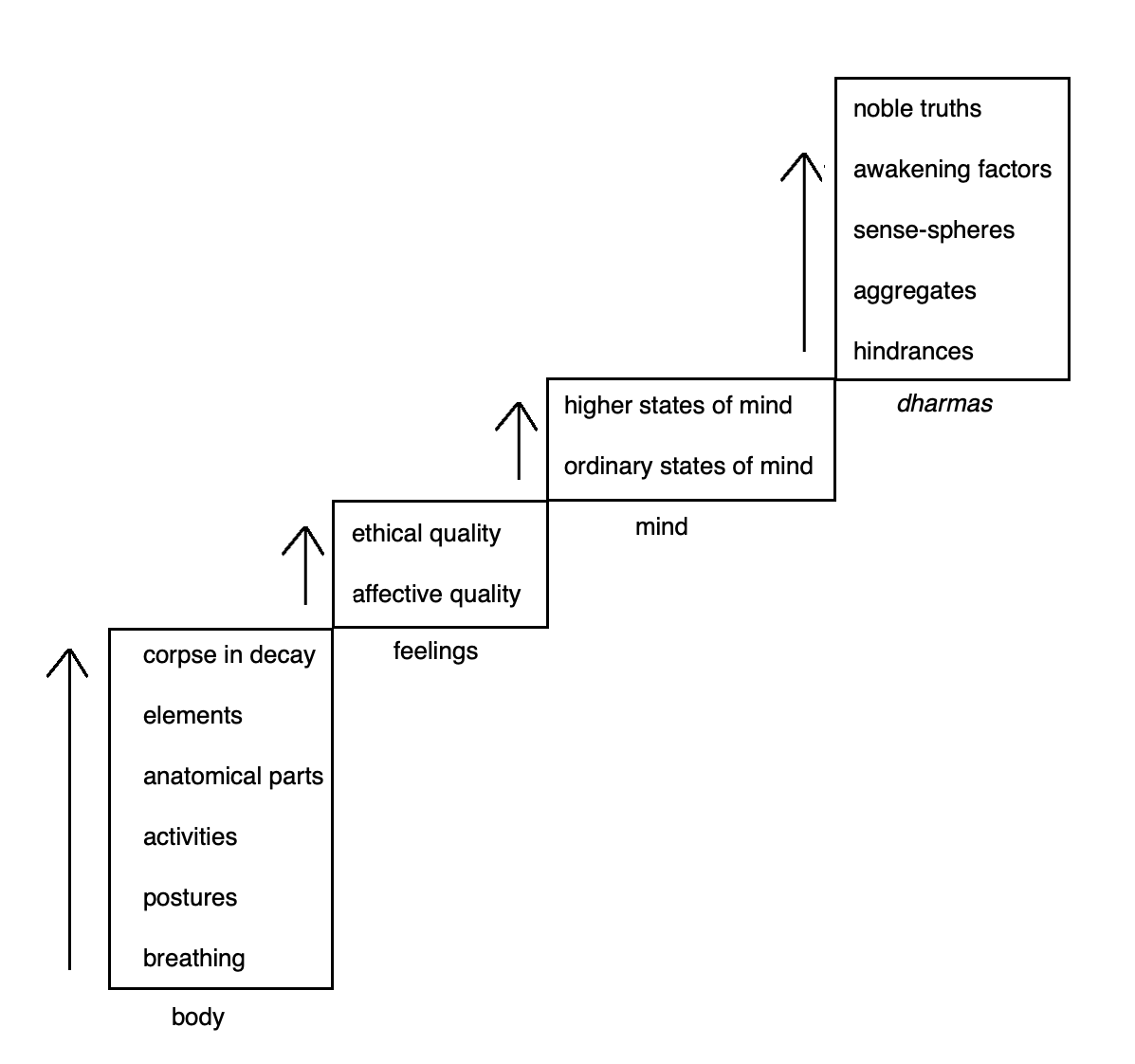User:Dorje108/sandbox2
Jump to navigation
Jump to search
the test1234
Survey of the four satipaṭṭhāna
Fig. 1: sequence of contemplations of the satipaṭṭhāna.

Bhikkhu Anālayo states:
- The sequence of the contemplations listed in the Satipaṭṭhāna Sutta reveals a progressive pattern (see Fig. 1). Contemplation of the body progresses from the rudimentary experience of bodily postures and activities to contemplating the body’s anatomy. The increased sensitivity developed in this way forms the basis for contemplation of feelings, a shift of awareness from the immediately accessible physical aspects of experience to feelings as more refined and subtle objects of awareness.
- Contemplation of feeling divides feelings not only according to their affective quality into pleasant, unpleasant, and neutral types, but also distinguishes these according to their worldly or unworldly nature. The latter part of contemplation of feelings thus introduces an ethical distinction of feelings, which serves as a stepping-stone for directing awareness to the ethical distinction between wholesome and unwholesome states of mind, mentioned at the start of the next satipaṭṭhāna, contemplation of the mind.
- Contemplation of the mind proceeds from the presence or absence of four unwholesome states of mind (raga, dosa, moha, and distraction), to contemplating the presence or absence of four higher states of mind. The concern with higher states of mind in the latter part of the contemplation of the mind naturally lends itself to a detailed investigation of those factors which particularly obstruct deeper levels of concentration. These are the hindrances, the first object of contemplation of dhammas.
- After covering the hindrances to meditation practice, contemplation of dhammas progresses to two analyses of subjective experience: the five aggregates and the six sense-spheres. These analyses are followed by the awakening factors, the next contemplation of dhammas.
- The culmination of satipaṭṭhāna practice is reached with the contemplation of the four noble truths, full understanding of which coincides with realization.
- Considered in this way, the sequence of the satipaṭṭhāna contemplations leads progressively from grosser to more subtle levels. This linear progression is not without practical relevance, since the body contemplations recommend themselves as a foundational exercise for building up a basis of sati, while the final contemplation of the four noble truths covers the experience of Nibbāna (the third noble truth concerning the cessation of dukkha) and thus corresponds to the culmination of any successful implementation of satipaṭṭhāna.
- At the same time, however, this progressive pattern does not prescribe the only possible way of practising satipaṭṭhāna. To take the progression of the meditation exercises in the Satipaṭṭhāna Sutta as indicating a necessary sequence would severely limit the range of one’s practice, since only those experiences or phenomena that fit into this preconceived pattern would be proper objects of awareness. Yet a central characteristic of satipaṭṭhāna is awareness of phenomena as they are, and as they occur. Although such awareness will naturally proceed from the gross to the subtle, in actual practice it will quite probably vary from the sequence depicted in the discourse.
- A flexible and comprehensive development of satipaṭṭhāna should encompass all aspects of experience, in whatever sequence they occur. All satipaṭṭhānas can be of continual relevance throughout one’s progress along the path. The practice of contemplating the body, for example, is not something to be left behind and discarded at some more advanced point in one’s progress. Much rather, it continues to be a relevant practice even for an arahant. Understood in this way, the meditation exercises listed in the Satipaṭṭhāna Sutta can be seen as mutually supportive. The sequence in which they are practised may be altered in order to meet the needs of each individual meditator.
- Not only do the four satipaṭṭhānas support each other, but they could even be integrated within a single meditation practice. This is documented in the Ānāpānasati Sutta, which describes how mindfulness of breathing can be developed in such a way that it encompasses all four satipaṭṭhānas. This exposition demonstrates the possibility of comprehensively combining all four satipaṭṭhānas within the practice of a single meditation.[1]
- ↑ Bhikkhu Anālayo 2003, Chapter I: General Aspects of the Direct Path.